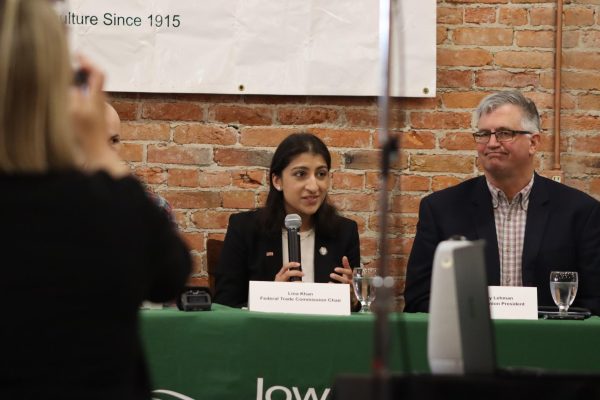ISU students volunteer at homeless shelter
September 17, 2001
by Anna Holland
Iowa State Daily
“How does tacos sound?”
It’s a normal Friday night.
Six ISU students are standing in the entrance of Fareway, talking about what to cook for dinner.
Everyone agrees on tacos. Someone grabs a cart, and the group navigates the aisles of the grocery store, debating along the way whether to add a head of lettuce, another pound of ground beef or a carton of fudge-swirl ice cream.
“How many people are there tonight, Kim?” someone asks.
“Troy said nine, so I’m planning on 10,” she answers. “Plus all of us, that’s 18.
“Did someone get shells?”
She smiles as another person in the group throws taco shells into the shopping cart.
“Okay. I think that’s everything,” someone says. “Let’s check out, then head over to the shelter.”
These students are not planning dinner for themselves.
They are part of a weekly group called the Emergency Relief Project from St. Thomas Aquinas Catholic Church and Student Center, 2210 Lincoln Way.
Kim Steffen, service and justice peer minister for St. Thomas, said the church has been sending people to cook for at least three years.
There’s more to it than just making food, she said.
“It’s not about us being the heroes,” Steffen said. “It’s about them teaching us about life every time we go.”
The group piles out of cars and walks up to the house, where several men are sitting on the porch. They say hello as people file into the house toting grocery sacks filled with food.
“We’re having tacos again,” Steffen says. “I’m really sorry. It’s been a hectic week.”
“That sounds great!” one man says. “Thumbs up.”
All six people pile into the small kitchen, opening cabinets and drawers to pull out pots, pans, knives and plates.
“I can’t make all four pounds at once,” Bryan says. “Can I get another skillet?”
“Hey, how are we going to serve this?” asks a girl named Sarah.
“Usually, we put everything into bowls,” Kim answers.
“That’s right. We eat everything family-style,” says Troy Jansen, the assistant director of the shelter, as he walks into the small kitchen. “We learned a lot from the `Waltons.'”
As he looks around the room at blank stares, something occurs to him.
“Do any of you know who the Waltons are?” he asks.
“Oh, sure!” someone says. “Jim Boy!”
“Um, Troy?” Steffen says. “This is kind of embarrassing, but we can’t figure out the can opener.”
“Oh, don’t worry,” he says as he opens a can of pineapple. “It gets a lot of people.”
As the smell of browning hamburger begins to fill the room, Troy goes over the “basics” of the shelter.
It’s a temporary shelter, he says, so the men who stay are only there for two weeks out of the year.
Finally, the meal is complete.
“We have fruit!” Sarah says, as she places a bowl of pineapple and mandarin oranges on the table.
Everyone gathers around the table. Troy says grace, and people begin passing food to each other.
The students sit enthralled as the men begin to tell their stories. One man talked about how he rides freight trains through the country.
He’s been at the shelter for a week.
“It’s my anniversary,” he says with a grin.
The men leave immediately after the meal finishes, but not before thanking the students who have shared their Friday nights with them.
Jansen, assistant director of the Ames Emergency Shelter, said the shelter is “really happy with the help” from ISU students.
“I think students bring energy,” he said. “They’re concerned, and the residents pick up on that.”
Jansen said students contribute to the shelter in many different ways. Residence hall floors, greek houses and student organizations hold canned food drives, paint, do yard work and donate cash, he said.
The Habitat for Humanity Blitzbuild in October 1999 added to the transitional housing for low-income families.
“[The students] have really given quite generously,” Jansen said.
Steffen said there’s a good reason for the generosity.
“I just feel like it’s so important to be aware of those people . who are marginalized,” she said. “I feel like I do my little part.”
Steffen said the experience is more meaningful for groups.
“I like to take groups there,” she said. “When you have a certain experience, you become aware.”
Bryan Steussy, freshman in liberal arts and sciences, had never cooked at a shelter before.
“When I first got there, it was kind of intimidating,” he said. “But they were so friendly. You think people might not be like that because of everything that’s happened in their lives, but they’re nice guys.”
Steussy said his experience was a good one, and he is “definitely” going back.
“It’s really cool,” he said. “It just teaches you not to judge people.”
As the group prepares to leave, a guy named Steve speaks up.
“You know,” he says, “the world would be a much better place if there were more people like you guys in it.”
His statement had quite an effect on Steussy.
“It was really cool for him to thank us like that,” he said.
















